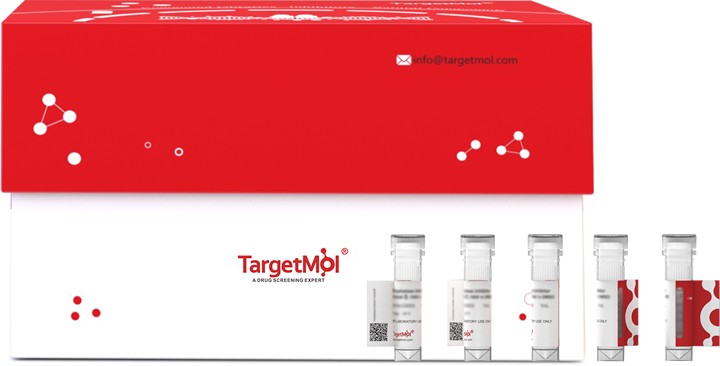- Remove All
 Your shopping cart is currently empty
Your shopping cart is currently empty
Prolyl Endopeptidase Protein, Mouse, Recombinant (His)
Prolyl endopeptidase, also known as PREP, belongs to a distinct class of serine peptidases. It is a large cytosolic enzyme which was first described in the cytosol of rabbit brain as an oligopeptidase. Prolyl endopeptidase degrades the nonapeptide bradykinin at the Pro-Phe bond. It is involved in the maturation and degradation of peptide hormones and neuropeptides such as alpha-melanocyte-stimulating hormone, luteinizing hormone-releasing hormone (LH-RH), thyrotropin-releasing hormone, angiotensin, neurotensin, oxytocin, substance P and vasopressin. Prolyl endopeptidase's activity is confined to action on oligopeptides of less than 10 kD and it has an absolute requirement for the trans-configuration of the peptide bond preceding proline. It cleaves peptide bonds at the C-terminal side of proline residues.

Prolyl Endopeptidase Protein, Mouse, Recombinant (His)
| Pack Size | Price | Availability | Quantity |
|---|---|---|---|
| 50 μg | $600 | 7-10 days |
Product Information
| Biological Activity | Activity testing is in progress. It is theoretically active, but we cannot guarantee it. If you require protein activity, we recommend choosing the eukaryotic expression version first. |
| Description | Prolyl endopeptidase, also known as PREP, belongs to a distinct class of serine peptidases. It is a large cytosolic enzyme which was first described in the cytosol of rabbit brain as an oligopeptidase. Prolyl endopeptidase degrades the nonapeptide bradykinin at the Pro-Phe bond. It is involved in the maturation and degradation of peptide hormones and neuropeptides such as alpha-melanocyte-stimulating hormone, luteinizing hormone-releasing hormone (LH-RH), thyrotropin-releasing hormone, angiotensin, neurotensin, oxytocin, substance P and vasopressin. Prolyl endopeptidase's activity is confined to action on oligopeptides of less than 10 kD and it has an absolute requirement for the trans-configuration of the peptide bond preceding proline. It cleaves peptide bonds at the C-terminal side of proline residues. |
| Species | Mouse |
| Expression System | Baculovirus Insect Cells |
| Tag | N-His |
| Accession Number | Q9QUR6 |
| Synonyms | prolyl endopeptidase,Pop,PEP,D10Wsu136e,AI450383,AI047692 |
| Construction | A DNA sequence encoding the mature form of mouse PREP (Q9QUR6) (Leu2-Gln710) was expressed, with a polyhistidine tag at the N-terminus. Predicted N terminal: His |
| Protein Purity | > 95 % as determined by SDS-PAGE |
| Molecular Weight | 82.9 kDa (predicted); 79-83 kDa (reducing conditions) |
| Endotoxin | < 1.0 EU/μg of the protein as determined by the LAL method. |
| Formulation | Lyophilized from a solution filtered through a 0.22 μm filter, containing 20 mM Tris, 500 mM NaCl, pH 7.4, 10% glycerol, 3 mM DTT. Typically, a mixture containing 5% to 8% trehalose, mannitol, and 0.01% Tween 80 is incorporated as a protective agent before lyophilization. |
| Reconstitution | A Certificate of Analysis (CoA) containing reconstitution instructions is included with the products. Please refer to the CoA for detailed information. |
| Stability & Storage | It is recommended to store recombinant proteins at -20°C to -80°C for future use. Lyophilized powders can be stably stored for over 12 months, while liquid products can be stored for 6-12 months at -80°C. For reconstituted protein solutions, the solution can be stored at -20°C to -80°C for at least 3 months. Please avoid multiple freeze-thaw cycles and store products in aliquots. |
| Shipping | In general, Lyophilized powders are shipping with blue ice. |
| Research Background | Prolyl endopeptidase, also known as PREP, belongs to a distinct class of serine peptidases. It is a large cytosolic enzyme which was first described in the cytosol of rabbit brain as an oligopeptidase. Prolyl endopeptidase degrades the nonapeptide bradykinin at the Pro-Phe bond. It is involved in the maturation and degradation of peptide hormones and neuropeptides such as alpha-melanocyte-stimulating hormone, luteinizing hormone-releasing hormone (LH-RH), thyrotropin-releasing hormone, angiotensin, neurotensin, oxytocin, substance P and vasopressin. Prolyl endopeptidase's activity is confined to action on oligopeptides of less than 10 kD and it has an absolute requirement for the trans-configuration of the peptide bond preceding proline. It cleaves peptide bonds at the C-terminal side of proline residues. |
Dose Conversion
Sci Citations
Calculator
Tech Support

Copyright © 2015-2025 TargetMol Chemicals Inc. All Rights Reserved.


